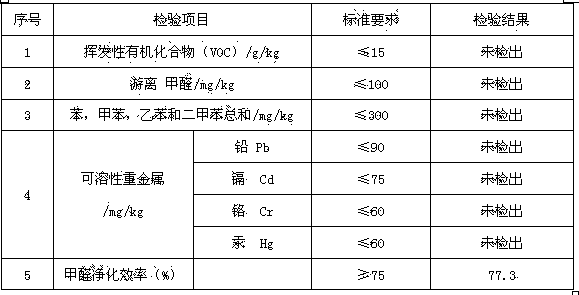Inorganic ecological wall mud dry powder and production method of inorganic ecological wall mud dry powder
An ecological wall, dry powder technology, applied in sustainable waste treatment, solid waste management, climate sustainability, etc., can solve the problems of polluted air, inability to use interior decoration for a long time, human injury, etc., to purify the indoor environment, enhance Breathability, the effect of protecting the natural environment
- Summary
- Abstract
- Description
- Claims
- Application Information
AI Technical Summary
Problems solved by technology
Method used
Image
Examples
Embodiment 1
[0019] An inorganic ecological wall mud dry powder, which comprises the following components by weight percentage: shell 40%, diatomite 15%, desulfurized gypsum 8%, sodium silicate 5.3%, calcium carbonate 20%, wood short fiber 1 %, cellulose 0.2%, iron oxide pigment 0.5%, quartz sand 10%. During production, the shells are firstly rinsed with water, dried, and then dried and crushed (the crushing mesh is 200). After crushing, the particles are classified with a grading sieve, and the classified powder is packaged for later use; then Put the crushed shell raw materials into the mixer, and then put diatomaceous earth, sodium silicate, desulfurized gypsum, calcium carbonate, wood short fiber, cellulose, iron oxide pigment and quartz sand into the mixer in the above ratio one by one. After the input is completed, stir for 15 minutes to make it fully stirred evenly, and measure and fill the evenly stirred dry powder of ecological wall mud to obtain the finished product.
Embodiment 2
[0021] An inorganic ecological wall mud dry powder, which comprises the following components by weight percentage: 30% shells, 20% diatomaceous earth, 8% desulfurized gypsum, 10% sodium silicate, 20% calcium carbonate, 1 wood short fiber %, cellulose 0.5%, iron oxide pigment 0.5%, quartz sand 10%. During production, the shells are firstly rinsed with water, dried, and then dried and crushed (the crushing mesh is 400). After crushing, the particles are classified with a grading sieve, and the classified powder is packaged for later use; then Put the crushed shell raw materials into the mixer, and then put diatomaceous earth, sodium silicate, desulfurized gypsum, calcium carbonate, wood short fiber, cellulose, iron oxide pigment and quartz sand into the mixer in the above ratio one by one. After the input is completed, stir for 15 minutes to make it fully stirred evenly, and measure and fill the evenly stirred dry powder of ecological wall mud to obtain the finished product.
Embodiment 3
[0023] An inorganic ecological wall mud dry powder, which includes the following components by weight percentage: 30% shellfish, 15% diatomaceous earth, 10% desulfurized gypsum, 8% sodium silicate, 20% calcium carbonate, 5% short wood fiber %, 1% cellulose, 1% iron oxide pigment, 10% quartz sand. During production, the shells are firstly rinsed with water, dried, and then dried and crushed (the crushing mesh is 300). After crushing, the particles are classified with a grading sieve, and the classified powder is packed for use; then Put the crushed shell raw materials into the mixer, and then put diatomaceous earth, sodium silicate, desulfurized gypsum, calcium carbonate, wood short fiber, cellulose, iron oxide pigment and quartz sand into the mixer in the above ratio one by one. After the input is completed, stir for 20 minutes to make it fully stirred evenly, and measure and fill the evenly stirred ecological wall mud dry powder to obtain the finished product.
PUM
 Login to View More
Login to View More Abstract
Description
Claims
Application Information
 Login to View More
Login to View More - R&D
- Intellectual Property
- Life Sciences
- Materials
- Tech Scout
- Unparalleled Data Quality
- Higher Quality Content
- 60% Fewer Hallucinations
Browse by: Latest US Patents, China's latest patents, Technical Efficacy Thesaurus, Application Domain, Technology Topic, Popular Technical Reports.
© 2025 PatSnap. All rights reserved.Legal|Privacy policy|Modern Slavery Act Transparency Statement|Sitemap|About US| Contact US: help@patsnap.com

